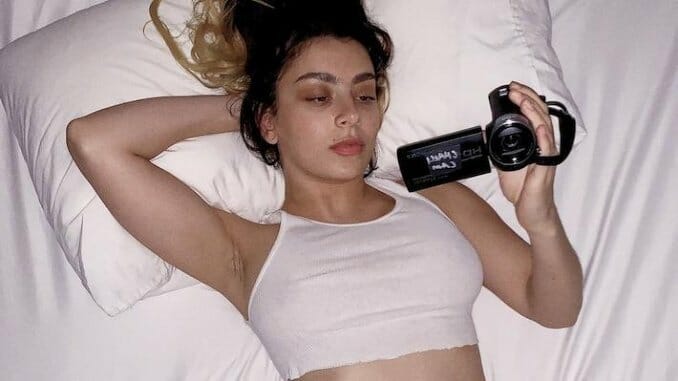Charli XCX Is Forced to Say Something Nice about Herself in Alone Together

If you were lucky, the early days of the pandemic were a time of bread and 30-day yoga challenges and bizarre celebrity offerings—to say nothing of the mass delusion that we’d be in this for a few more weeks, max. If you happen to be creatively inclined, they may also have presented an opportunity to abandon your usual outlets and/or methods, to figuratively (or maybe not) throw some things at the wall.
English singer-songwriter Charlotte Aitchison, aka Charli XCX, fell into both categories when that fateful Friday the 13th hit. She did the baking and the exercising (and a little deejaying for Grindr), but soon thereafter landed on her real quarantine project: How I’m Feeling Now, an 11-track album recorded over six weeks in April and May of 2020. Aside from the unusual speed with which she churned it out, the project was novel for her in that she invited her fans (known as her Angels) to be part of the process. That spring, thousands of them workshopped lyrics on Instagram Live, sent in clips for music videos and designed artwork for multiple singles. “The nature of this album is gonna be very indicative of the times,” Charli wrote in her initial announcement on Instagram, “just because I’m only gonna be able to use the tools I have at my fingertips.”
Upon reading that same announcement in the first week of April, directing duo Bradley & Pablo—themselves in the market for a quarantine project, and frequent collaborators of Charli’s since 2016—reached out with the idea of enshrining the experience in documentary form. When the star agreed, they sent some cameras to her home in Los Angeles, and organized a handful of Angels around the world to document the same period from their perspectives. (They were, after all, set to be Charli’s main collaborators.) The finished film is the hour-long Alone Together, which closed last year’s SXSW festival and hits theaters and VOD this Friday. And while the doc is ostensibly yet another pop star chronicle in an era of constant pop star chronicles, it emerges as a surprisingly universal study in being a creator of any kind in the digital era—watching in horror as your ambitious self-imposed deadline approaches, navigating how generous you should be with your audience, saying unkind things to yourself for no real reason, and so on.
When it comes to the latter habit, Charli is an especially bad offender. Narrating the film’s opening segment, a montage of her career through early 2020, she explains that the pandemic caught her in the middle of her Charli Live Tour—not her first one, but the first where she’d finally found her groove after years of feeling unsung amid creative highs and unfulfilled amid commercial ones. Her fanbase had also ballooned by the end of the 2010s, and she felt a unique kinship with her LGBTQ+ Angels, who embolden her as an artist and person. Despite all of this, patting herself on the back is an ongoing struggle; a sense of perpetual unfulfillment is one of several “serious issues” she lists with her approach to work. Worried that this collective behavior was hurting some of her relationships, including the one she has with herself, she’d coincidentally started seeing a therapist just a couple weeks before L.A.’s stay-at-home order took effect.
Another relationship of concern is that with her long-distance boyfriend, Huck, who finds himself unexpectedly quarantining with her during what was meant to be a shorter visit to L.A. (Despite having been a pair for the better half of a decade, we learn that they’ve somehow never before spent more than a couple weeks together.) Charli names him to her fans as the album’s muse—out of convenience, she explains, but also for some of the same reasons she’s in therapy: “There are a lot of things that we needed to kind of talk about, and kind of…rescue.” Huck, who’s credited as one of Alone Together’s cinematographers, dials up the film’s funniness as well as its emotional stakes. There’s more riding on getting this album finished, it seems, than merely delivering it on time.
-

-

-

-

-

-

-

-

-

-

-

-

-

-

-

-

-

-

-

-

-

-

-

-

-

-

-

-

-

-

-

-

-

-

-

-

-

-

-

-








































